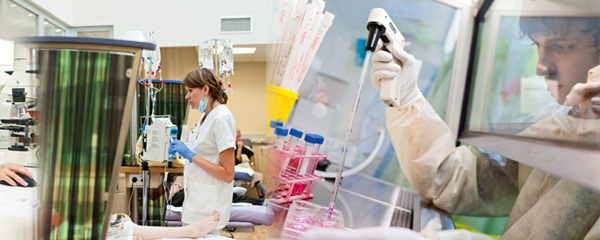The term “adjuvant treatment” can apply to all types of anticancer therapy (radiotherapy, immunotherapy, hormonotherapy, etc.) added to back up the main treatment. For example, “adjuvant” chemotherapy is administered after surgery and/or radiotherapy on a tumour. An adjuvant therapy is intended to consolidate and secure the main treatment in order to reduce the risk of relapse or the formation of metastases.
You are here
Glossary
Adjuvant
Allograft
Allografts are, for example, the transplantation of a kidney from a person (donor) to another person (the recipient). Since the genetic heritage of one individual is different to that of another, the aim is to select donors or grafts that present the fewest possible differences, thus with the most “histocompatibility”. This can be the case between a closely related donor and recipient. The recipient must take immunosuppressive drugs so that the body’s immune system accepts an organ not belonging to it and thus reduce the risk of rejection.
Anatomical pathology
This term, which is long and difficult to pronounce, is sometimes shortened to “anapath” in medical circles. This discipline specialised in studying diseased tissues is practiced by anatomical pathologists.
In oncology, it consists of macroscopic examination, otherwise known as naked eye examination, and microscopic (or histological) examination of the organs, tissues or cells removed and which are known or suspected to be malignant. They determine whether a tumour is cancerous or not, and provide highly useful information on its type (carcinoma, sarcoma, etc.) and stage of evolution.
Antibodies
Antibodies are complex proteins that are part of the blood. They intervene in the immune system (the body’s defence system). They are secreted by plasmocytes (components derived from white blood cells or B lymphocytes) in reaction to the introduction of foreign elements in the body.
These foreign elements are composed of small (most usually peptidic: small proteins of about ten amine acids) elements called antigens recognised by the antibodies and against which they react. The human body contains several billion antibodies. A virus, bacteria, fungi, parasite, venom, poison, vaccine, a cancer cell, etc. can therefore be recognised by the antibodies as noxious elements to be eliminated.
Antibodies react against the antigen that caused their secretion. They fix specifically to this antigen and mobilise other components of the immune system to neutralise and eliminate it from the organism.
Antibodies are often represented by a Y. They are composed of identical parts for all the antibodies of the same organism and variable parts. The variable parts allow recognising foreign bodies and are located at the end of the arms of the Y. They permit an adapted and targeted immune action. An antibody cannot fix to the antigen that caused its secretion except in specific cases of molecular mimetism.
The immune system is able to distinguish undesirable foreign elements from the elements making up the organism, except for cases of auto-immune diseases (the organism comes under attack by its own immune system).
Antibodies are used in medicine to prevent or treat certain diseases like tetanus, chicken pox, some types of hepatitis, scarlet fever, mumps, etc.
Antigen
An antigen is a molecule foreign to the body (for example, stemming from a virus, bacteria, toxins) or an abnormal entity in the body (cancerous cells) liable to trigger an immune response. When the antigen is recognised by the antibodies and/or white blood cells (lymphocytes), the immune system combats the antigen and attempts to eliminate it.
Apoptosis
Apoptosis or programmed cell death. It is a normal, intrinsically programmed cellular mechanism through which cells self-destruct in response to an internal signal.
This phenomenon ends in the death of individual cells, in certain places at specific times. Apoptosis is the mechanism the organism uses to rid itself of non-utilisable, undesirable and potentially noxious cells.
This mode of cell death serves to balance cell multiplication (also called homeostasis) by regulating the size of tissues. Apoptosis occurs in many other biological processes such as embryonic development, and the regulation and functioning of the immune system.
Apoptosis is often deregulated by the development of a cancer.

